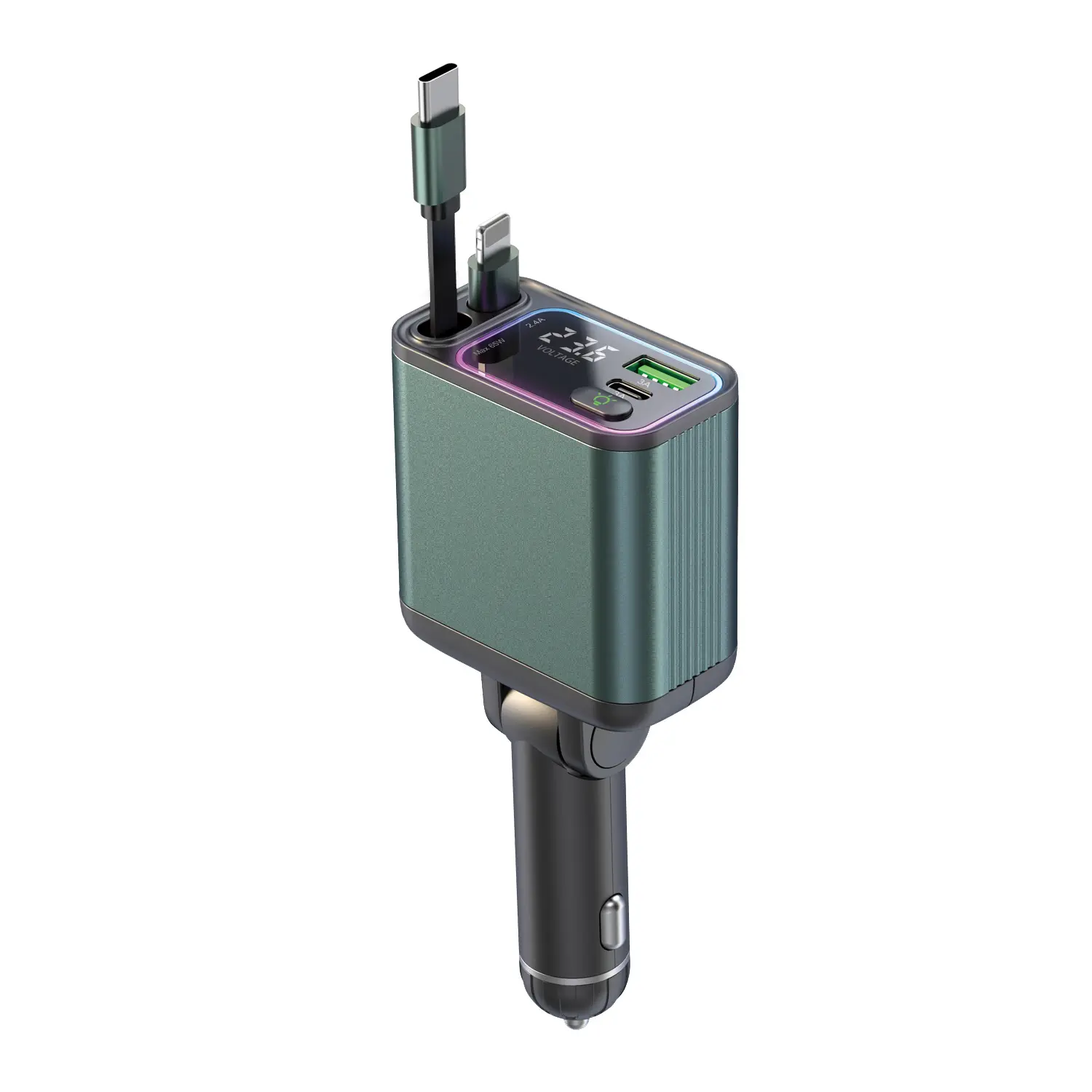Retractable chargers make electric vehicle charging much easier since they take care of all that messy cord business. Homeowners no longer need to wrestle with thick cables or deal with knots forming in their garage space. The system just extends and retracts as needed, keeping things looking neat without any effort from the user. Public charging spots see real advantages too. According to research from the Electrification Coalition back in 2023, these retractable options cut down on setup mistakes by around 40% when compared to regular fixed cables. And let's not forget safety aspects either. Shopping mall parking lots can get pretty crowded during peak hours, but those self-winding designs help prevent accidents caused by loose wires lying around. A recent McKinsey report actually showed that nearly three quarters of drivers really value convenience above all else when it comes to finding charging stations.
When it comes to connection times, automated retraction makes a real difference. Tests from SAE International show that these systems cut down the average time by around 19 seconds each session, which is actually a 33% improvement compared to those old fixed cables. Think about what this means for places like fleet depots. Technicians there handle dozens of charges every day, sometimes upwards of 50 or more. With all those connections, they end up saving close to three whole hours every week. The ergonomic advantages shouldn't be overlooked either. Retractable systems need only about 40% of the pulling force required when someone has to drag those heavy fixed cables across rough parking surfaces. This makes a big difference for workers who might have mobility issues, since the equipment meets ADA standards and is simply easier to manage for everyone involved.
Retractable mechanisms work really well in tight spaces where there isn't much room to maneuver. They help cut down on ground drag which often damages connectors costing around $740,000 every year for repairs in city charging stations. When looking at multi unit buildings specifically, retractable systems have been shown to lower accident rates related to cable slack by about 89% when compared with traditional fixed setups according to data from National Safety Council back in 2023. Another big plus is how they handle angled parking situations. People who park their cars at right angles can just pull out whatever length they need without dealing with all that extra cable hanging around. Apartment dwellers seem to love this particular feature too — surveys conducted by ChargePoint found that roughly two thirds consider it absolutely essential for good usability.
The durability issues facing retractable cables are quite specific to their usage patterns. According to recent findings from the 2023 EV Charging Infrastructure Report, about 43 percent of early failures happen because these cables get exposed to harsh environments. Extreme temperatures tend to crack the insulation and corrode connectors over time. The constant pulling and pushing during retraction takes a toll on conductors inside the cable as well. Public charging stations present another problem when users don't handle them properly, creating weak spots along the length. Fleet operators in city areas report around 2.5 times higher abrasion rates compared to home chargers simply because their vehicles charge every day in busy locations where cables get dragged across concrete and other rough surfaces regularly.
Manufacturers enhance longevity through advanced engineering:
People worry about all those moving parts, but modern retractor systems actually have pretty impressive reliability. The failure rate drops down to around 0.19% after 10,000 operation cycles if someone takes care of maintenance regularly. When it comes to water resistance, IP67 rated gear really stands out compared to older models in places where flooding is common. Those sealed bearings keep most problems at bay too, stopping about 92 percent of issues caused by moisture getting inside. Still, nobody wants to force something that's stuck, which can cause real damage. That's why higher end models now come with automated tension sensors. These little gadgets cut down on mistakes made by humans trying to fix things manually, reducing damage incidents by roughly 81% according to field tests.

Over the course of twelve months, researchers looked at around 200 retractable charging stations installed in various Chicago high rise buildings. These devices maintained an impressive 97 percent uptime even when dealing with extreme weather conditions, from bone chilling minus twenty degrees Fahrenheit all the way up to blistering heat of 105 degrees. At Denver International Airport, fleet managers noticed something interesting too. After making the switch to those heavy duty retractable charging solutions, they found themselves spending about forty percent less on replacing damaged cables. Maintenance records tell another story as well. The average time between needed repairs jumped from just eight months for traditional fixed cables to thirteen months with the new retractable models. And then there are those luxury condos in busy areas where people constantly come and go. Property managers report seeing roughly sixty three percent fewer accidents caused by tripping over loose cables since implementing these smart cable management systems throughout common spaces.
Retractable charging solutions get rid of those cumbersome cable storage issues that create so much mess in crowded city parking spots and home garages alike. According to research published last year on urban electric vehicle infrastructure, these compact designs actually cut down the physical space needed at charging stations by around 37 percent when compared to traditional fixed cable installations. For people living in apartments or houses with limited space, wall mounted retractable systems offer a neat way to keep cables out of sight. Not only does this prevent accidental trips over loose wires, but it also keeps expensive charging equipment safe from rain damage and other weather related problems that can shorten their lifespan significantly.
Modular designs work great for mounting either vertically or horizontally on walls, ceilings, even pillars. This makes them perfect for those tight spaces in parking garages where headroom is less than eight feet. According to recent data from the 2024 Multi Unit Dwelling Electrification Report, apartments that install shared EV charging stations see adoption jump by around 62% faster when they use retractable cables instead of fixed ones. What's really nice about these systems though? They fit right into existing electrical infrastructure without needing expensive renovations or construction work.
While fixed cables offer simplicity for high-traffic commercial sites, retractable alternatives reduce maintenance costs by 29% in environments with limited staff oversight (Fleet Charging Efficiency Index, 2023). The table below highlights key differences:
| Feature | Fixed Cables | Retractable Chargers |
|---|---|---|
| Average Space Required | 4.2 sq ft | 1.8 sq ft |
| Annual Maintenance | $220 | $155 |
| User Satisfaction | 73% | 89% |
This data explains why 78% of new urban EV installations now favor retractable systems for long-term space optimization and user convenience.
The price tag on retractable EV chargers usually runs around $300 to $600 higher than standard fixed systems because they come with all those moving parts and sturdier casings. Interesting thing though, according to the 2023 EV Infrastructure Report, most commercial installers actually spend less time and money installing these retractable versions since they're easier to mount. Fixed cable options still sit in the $1,200 to $1,800 range per station which is pretty reasonable for budgets, but honestly they just don't offer the same flexibility or readiness for what comes next compared to their retractable counterparts.
A 3-year study of 4,500 charging ports shows retractable systems require 40% fewer cable replacements despite mechanical complexity. Automated retraction prevents:
Fixed cables require 2.3 times more annual maintenance, especially in high-use locations like fleet depots.
Although retractable chargers cost 25–35% more upfront, they achieve 92% sustained user adoption rates in shared parking environments—compared to 78% for fixed systems. This translates to $18,700 greater lifetime revenue per station (2024 EV Charger ROI Report). Operators also report 60% fewer downtime incidents due to protected connectors and organized cable management.
Retractable EV charging cables offer numerous benefits such as user convenience, neatness, reduced setup mistakes, safety, ergonomic advantages, and lower maintenance costs.
No, retractable EV chargers actually require less maintenance than fixed ones due to their design which minimizes wear and tear and reduces the chance of damage.
Yes, retractable charging cables typically cost $300 to $600 more than fixed ones initially, but they offer long-term savings in maintenance and provide higher user satisfaction.
Retractable systems are safer and more accessible as they prevent accidents caused by loose wires and are easier to handle, especially in tight or shared parking spaces.

Copyright © 2024 Shenzhen GXY Electronic Co.,LTD All Rights Reserved Privacy policy